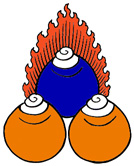| |

Studies
in
Buddhadharma
On the
Noble Eightfold Path
 Contents
Contents  SiteMap
SiteMap

"And what monks, is that middle
way awakened by the Tathâgata ? It is this Noble Eightfold Path ; that is,
right view, right intention, right speech, right action, right livelihood,
right effort, right mindfulness, right concentration. This monks, is
that middle way awakened by the Tathâgata, which gives rise to vision,
which gives rise to knowledge, and leads to peace, to direct knowledge, to
enlightenment, to Nirvâna." -
Samyuktâgama (Samyutta-nikâya), 56.II, verse 421.
|
|

The Dharmacakra as the
eight spokes of the heart cakra
made of white peals or bone and worn as a breast ornament |
|
|
The wheel is an Ancient
Indian symbol of creation, power, protection and the Sun. As a Solar
symbol it appears on clay seals found in the Indus Valley belonging
to Harappan culture. Of universal appeal, it can also be found in
Ancient Egypt (namely hieroglyph N5) and in Western astrology &
alchemy.
The wheel also represents motion & change. As an
Indian weapon of war, it had sharp blades and was rolled into the ranks of the
enemy, swung on a rope or hurled as a discus. Its destructive power
was pertinent.
In Buddhism, it
represents the "cakravartin" or "wheel turner", setting the "wheel
of the law" or "dharmacakra" in motion. Moreover, the
truth of the path of the Buddha
brings rapid spiritual transformation, change and has the power to
overcome emotional instability (desire & hatred) and mental delusions (ignorance). It is a symbol of
skillful method, the way to
steer well in the light of day & the darkness of night, symbolizing conventional truth and
the realm of dependent arising.
The hub of the wheel symbolizes
morality ("śila"), the spokes the
absorptions ("dhyâna") of calm abiding ("śamatha") as well as the
Noble Eightfold Path, whereas the rim is the
wisdom ("prajñâ") attained by insight
meditation
("vipaśyanâ"). |
In his First Discourse, the
wisdom leading to enlightenment or entry in "nirvâna" was taught by
Buddha Śâkyamuni in terms of four interlinked propositions known as the
Four Noble Truths ("cattâri
ariyasaccâni"), covering the central tenets of the
Buddhadharma. The First
and the Second Noble Truths deal with "samsâra",
its
pervasive suffering and
causes of suffering. The Third Noble Truth
introduces "nirvâna",
the message of true peace (or cessation of suffering) inherent in Buddhist wisdom, as well as the
Two Truths. Finally, in the Fourth Noble
Truth, the Truth of the Path, the Buddha taught the Eightfold Path, the
way out of cyclic existence.
This First
Discourse can be found in the second basket of the
Tripitaka as "Setting in Motion the Wheel of the Dharma"
(Samyutta-nikâya, 56.II).
The Four Noble Truths follow the pattern of a medical anamnesis, with (a)
diagnosis, (b) identification of causes, (c) curability & (d) method of
treatment, or therapy :
1. the truth of suffering
: diagnosis : caught in & trapped
by cycles,
sentient beings suffer ;
2.
the truth of arising
: etiology : their ignorant craving chains sentient beings
to cycles ;
3. the truth of cessation
: curability : the suffering of all sentient beings can be ceased
by way of wisdom ;
4.
the truth of the path : treatment : train in merit &
wisdom in accordance with the Noble Eightfold Path.
THE NOBLE EIGHTFOLD PATH
The path ("marga")
proposed by the Buddha is the Treefold Training ("triśikśa"). These
"higher" trainings involves
morality ("śila"), the practice of
meditation ("samâdhi") and
wisdom ("prajñâ"). These are interdependent conditions, and
so all need to be present in order for the cure to have effect (the end of
suffering).
The Noble Eightfold Path is called the "middle way". It steers
between indulgence and austerity, between too much & too little. The eight factors, rather than being
stages of a process, exemplify how
morality, meditation & wisdom have to be practiced on a daily basis. They
define how a Buddha lives and so by living like a Buddha, one gradually
becomes one (this is the causal path).
The common element in these higher trainings is their reliance on the
wisdom eventuating reality without any conceptuality, in a nondual mode of
cognition. In such an enlightened state,
sensation equates perception.
In the practice of the Eightfold Path, wisdom & morality (as
compassion), are like two baskets, filled by the ongoing practice of
meditation :
WISDOM
1. Right Understanding (or Right View) : acceptance and experiental confirmation
of the teachings of the Buddha (the "Dharma") ;
2. Right Resolve (or Right Intent) : the commitment to develop right attitudes
;
With a wrong view, the path is rejected before the cure can take effect.
This is like a patient who rejects therapy. So even
if the cure is approached with right understanding, which is the primary
cause of healing, secundary causes are necessary. These imply changing
attitudes, contexts & conditions.
MORALITY
3.
Right Speech : tell the truth and speak in a thoughtful
& sensitive
way ;
4. Right Action : abstain from wrongful bodily behaviour (killing, stealing,
mindless
intoxication,
and wrong sensual pleasures) ;
5. Right Livelihood : do not harm others by one's occupation
(commerce in weapons, living beings, meat, intoxicants & poison are
forbidden) ;
Morality is a fence to protect the young, vulnerable shoots. It develops
right attitudes and allows one to accumulate
merit.
MEDITATION
6. Right Effort :
control the mind and gain positive states of mind ;
7. Right Mindfulness : cultivate constant awareness
in a proper way ;
8. Right Meditation : contemplate certain
crucial topics (analytical meditation), experience Calm Abiding, and realize emptiness (by
way of Insight
Meditation).
Meditation supports both morality (merit)
& wisdom. Right
view leads to right intent. This causes right speech, leading to right
action causing right livelihood. The latter causes right effort, leading
to right mindfulness causing right meditation.
We may assume the renouncers
("samanas") & orthodox Vedic practitioners ("brâhmanas")
of pre-Buddhist India practiced
eight levels of meditative absorption ("dhyâna" or "jhâna"), integrating
both form and
formless realms. In a general sense, "dhyâna" is the means by which "samâdhi" is
attained. In Classical Yoga, recorded in the
Yoga-sûtra of Patañjali (dating from the
2th century CE), "dhyâna" preludes "samâdhi" or "union". The latter has
two divisions resembling the absorptions : (a) union with coarse or subtle
seed (form) and (b) union without seed (formless). "Dhyâna" is often
called "concentration" because perfect "dhârâna" or "concentration" proper
equals "dhyâna". The latter is best translated as "contemplation".
In the Buddhadharma, "dhyâna", "samâdhi" and "jhâna" are used
interchangeably.
In "śamatha" meditation, i.e. "dwelling in tranquility" or "Calm Abiding",
which has nine stages, these absorptions are identified as levels of
deepening mental calm. To supplement these,
Śâkyamuni developed "Insight Meditation"
("vipaśyanâ"), which, through the analytical examination of
emptiness, leads to the direct
experience of reality as it is, to suchness. Insight Meditation applied to
emptiness is the
core of the spiritual practice advocated by the Buddhadharma. To view the wisdom realizing the
ultimate nature of phenomena, namely emptiness, as the heart of meditation, is to introduce a truly
philosophical yoga.

|
|




